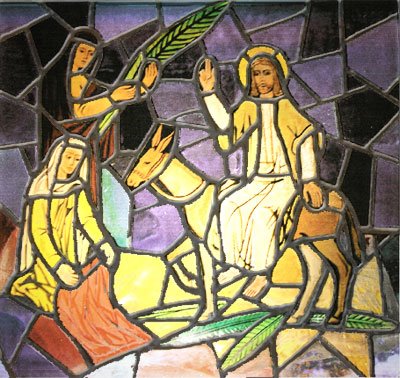[Please see the updated, 2010 version of this here.]
 Palm Sunday commemorates the day Jesus entered Jerusalem on the back of a colt (or donkey) with throngs of Messianic enthusiasts paving the way with palm fronds. Celebrations of this holiday therefore often include palms.
Palm Sunday commemorates the day Jesus entered Jerusalem on the back of a colt (or donkey) with throngs of Messianic enthusiasts paving the way with palm fronds. Celebrations of this holiday therefore often include palms.
In some regions, however, this tropical plant has been difficult to acquire, particularly in the past when shipping methods were primitive. For this reason, local trees were often substituted for palms, and the name of the holiday revised to match.
Were Christians who celebrated “Yew Sunday,” because their culture knew yews and did not know palms, practicing a heresy? Other-Than-Palm Sundays certainly could be described as “un-scriptural” but are they un-Christian? We don’t think so, and we think that this is a critically important point that supports our idiomatic, rather than dogmatic, approach to religious creed.
The laying of palm fronds is a symbol used to express a particular meaning: triumphant arrival. So long as the meaning remains intact, the symbol itself is truly arbitrary. Put another way, the meaning is the pointer to spiritual truth, while the symbol is merely the material from which that pointer is crafted.
Focusing on the material particulars, rather than on the universal spirit of the matter, is religiously perilous. In fact, it trends toward idolatry.
This is why, for example, the emmisarial nature of Christ can be described in so many ways. Christ is the Son of God, the Name of God, the Word of God, the Image of God and, of course, the Annointed of God since this is what the Greek “Christ” and Hebrew “Messiah” actually mean. These are very different symbols, but all have the same meaning.
The language used is merely idiom; the underlying spiritual truth is the true essence of religion.
And idiom can take the form of actual words, or any other arbitrary pointer. For example, there is a controversy (although a rather mild and obscure one) over whether Sunday was actually the weekday in which Jesus entered Jerusalem, counting backward from the reported day of Crucifixion Friday, which is said to have happened on the 14th day of the Hebrew month of Nisan (נִיסָן). Since the entry was supposed to have happened on the day of preparing the Passover lambs, traditionally the 10th of Nisan, a little grade-school math reveals an inconsistency.
So, are we wrong to commemorate the arrival of Jesus in Jerusalem on Sunday and the Crucifixion on Friday? AUR thinks not. Regardless of the day of the week, honoring Palm Sunday to revisit the meaning of that day is what is truly important.
In the same way, AUR honors Thursday not because it is particularly important which day of the week one sets aside to worship, but to emphasize the importance of moral commitment to the process of salvation by celebrating when Jesus accepted the Passion: during prayer in the Garden of Gethsemane. Depending on where one stands on the Easter dating controversy described above, this may or may not have happened on Thursday. Regardless, it is the meaning of “nevertheless Thy will be done” that matters to us, not the arbitrary weekday used to commemorate it.
Although we honor Thursday as the day of Jesus’s moral commitment, we also recognize that this weekday is merely idiom. If the Last Supper actually took place on Wednesday or Friday, this doesn’t change the meaning of the events of that day, or make Thursday worship “incorrect.” The particular time of honoring virtue is arbitrary, but having a time to honor virtue is not.
So, in celebration of the beginning of Holy Week, let us lay palm fronds, or yew branches, or even flowers, but keep in mind the meaning behind this imagery: welcoming the arrival of the Image of virtue whose spiritual victory is in accepting the necessary and painful contingencies of a life “in the flesh.”
[originally published 13 March 2008]
